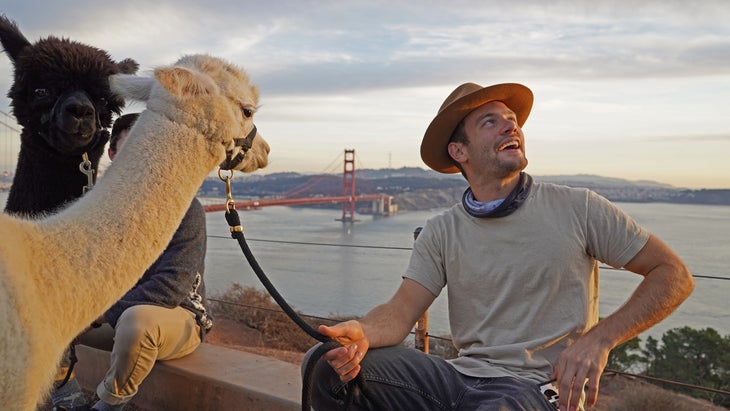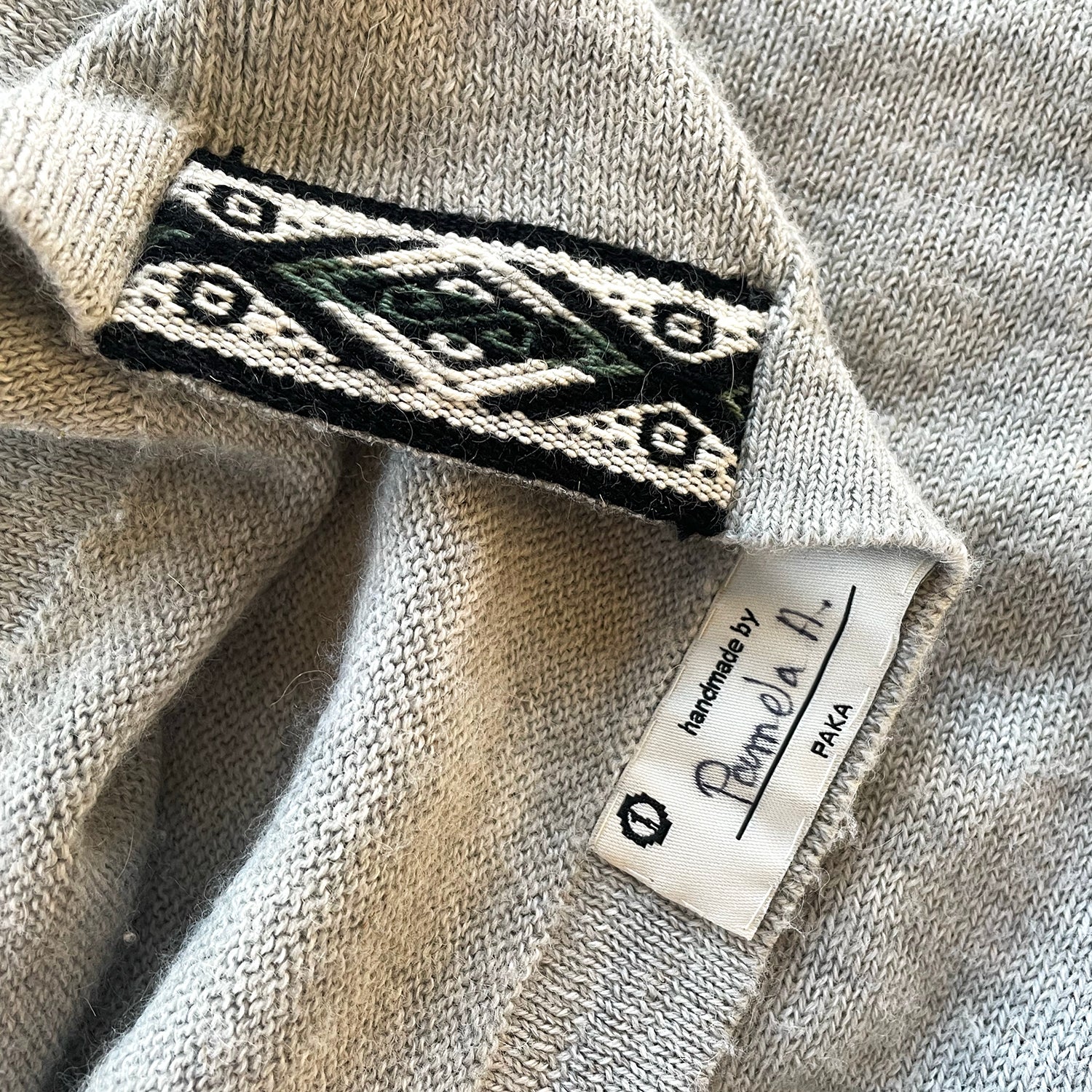As a gearhead who mostly tests running shoes and apparel made for high-energy activities, I don’t often fire up about a sweater. But when I pulled on for the first time, I didn’t want to take it off.
I wore it while working at my desk. I wore it while walking my dog. I even ran about a mile in it on a cold evening during a youth soccer practice when I felt like I just needed to move. I especially love pulling it on after a day outside on snow. The thing is ridiculously soft and warm, and it looks good, too.
You’d think my favorite new sweater would be made out of the natural fiber we all know and love thanks to brands like Smartwool, Ibex, and Icebreaker: Merino wool. But there’s a new natural fiber that may just give good-ole Merino a run for its money: alpaca.
Merino (a type of sheep) wool and alpaca fleece both come from cute, fluffy animals that are sheared without harm typically once a year. Merino and alpaca both consist of hollow fibers with amazing properties that keep the animals—and humans—warm when it’s cold and cool when it’s warm, regulating body temperature. Both fibers naturally resist odor, wick sweat, and breathe well. And they’re both biodegradable and renewable. So, is one better than the other?
According to Kris Cody, founder of the quickly growing outdoor apparel company Paka, the superior fiber is the wool from the animals that live in the Andes Mountains of South America: the alpacas.
A Relationship with an Alpaca Sweater
Ten years ago, while taking a gap year before college and backpacking through South America, Cody stumbled upon a sweater handknit by a Peruvian woman at a street market in Cuzco, Peru. “That sweater became my companion,” says Cody, who recently opened an office in Boulder, Colorado and now has 20 employees stateside. “It worked in every single climate on my trip. I built a relationship with that sweater.” So much of a relationship that when the then-18-year-old started college to study neuroscience at the University of Virginia that fall, he couldn’t get the sweater—and its origin—out of his mind. Or heart.
“I just felt such a connection back to Peru—the culture, the people, and the sweater. I didn’t want to lose it.” The fact that seemingly everyone at UVA kept asking him where he got the sweater, coming up to touch it, and marveling that it felt as soft as cashmere further flamed his love affair.
“I was fascinated because it feels like a luxury, fashion fiber,” he says. “And I recognized the fact that this animal [the alpaca] had evolved in the craziest climate on the earth where you freeze and burn in the same day with 70-degree temperature fluctuations. In looking at the fiber and the hollow air pockets and how much function was embedded, I thought that it would be really revolutionary for the outdoor apparel industry.”

At 19 years old and just having finished a year of college, Cody bought a one-way ticket to Peru to track down the woman who had sold him the sweater. “I flew back with no business plan but wanted to get to know the family of weavers.” He spent a couple of weeks retracing his steps from his trip a year earlier, searching for the weaver who had sold him his sweater. “I was just so interested in finding the real source of where it came from,” he says. His persistence and the fact that “Cuzco’s not so big” led to success.
When he finally stumbled upon the right doorstep, he explained his obsession to the local Peruvian weaver, Gregoria. Though skeptical at first, Gregoria trusted Cody enough to introduce her to her family, and her weaving process. Cody says he lived on the family’s rooftop for weeks. “It just became this relationship of getting to her family and learning more and working on some ideas and prototypes in her kitchen. We began sharing this dream of, ‘What if we brought this to the U.S.? What, and how, do we do this in a way that works and that represents the culture?’ It was a collaboration.”
Cody came home with a bag of 50 sweaters that he sold on Shopify out of his dorm room. A year later, he returned to Peru with a film crew to create about the origins of the sweaters he’d been selling with the intention to spread the word and launch a Kickstarter campaign. The video, which highlighted the Peruvian people and alpacas, went viral, and Paka was born.
Fast-forward eight years, and Paka employs 300 weavers in Cuzco. The company aims to multiply each weaver’s income by eight percent, helping to improve the statistic that one in three children under 5 years old in Cuzco suffer from malnutrition. The company contributes one percent of annual sales to female education, helping young Peruvian women attend university. Through its partnership with a local nonprofit, Paka assists women of neighboring communities of Cuzco to learn how to weave, allowing many to move from manual labor like farming to skilled, artisanal traditions passed down from the Inca. Each sweater is signed on the tag by the woman who made it. Mine is signed by “Pamela A.” On one side is a small emblem of an adorable alpaca and on the other side a tiny woven patch (which the company calls an Inca ID).
I am, in fact, wearing my cozy, cashmere-like as I write this. I wish I had kept the biodegradable tag that came with it (and comes with every Paka item), because on that tag was a QR code—a source certificate—that would have allowed me to trace my sweater back to the exact adorable, fluffy alpaca from which its fibers were sheared, cleaned, dyed (with environmentally friendly dyes), woven, and knit.
Even if I don’t know the details, my sweater—and my other Paka apparel—channels an Andean alpaca and every person who went into making it every time I wear it.
Alpaca’s Unique Qualities
There is nothing wrong with Merino wool. I love Merino wool. But alpaca, Kody says, has several unique characteristics.
“I love Merino wool as well,” says Kody. “I think there are a lot of benefits for both of them, and also reasons to synergize alpaca and Merino, because the structure is very different.” Kody explains how alpaca fiber is hair-like and Merino a crimped fiber, which means that Merino wool adds volume to garments while alpaca does not, giving alpaca a greater insulating capacity with a lower weight. “It’s the medullated air pockets in alpaca that make it three times warmer than merino,” he says.
Alpaca, he says, is softer, and three times lighter than sheep’s wool. It tests warmer than Merino and has half of the moisture retention of Merino, which, Kody explains, translates to less bacteria build-up and thus, less odor.
“In my opinion,” he says, “alpaca is the most odor-resistant fiber you could ever wear. It repels moisture because these air pockets inside of the fiber hold heat and repel water.” It’s those same air pockets that give it thermoregulation properties. “I think that is the super-strength of alpacas having evolved in 70-degree daily fluctuations. That thermal regulation story is really what we are focusing on the most.”
So, why aren’t more brands using alpaca? While Merino wool has been utilized by numerous outdoor companies for years—with great success—the framework for using alpaca is still a new frontier. Kody points to the “vertical infrastructure” he and his team have built by spending time on the ground in Peru with 7,560 alpaqueros (alpaca cowboys) employed by Paka, the local weavers, and other artisans involved in the process.
“I think it’s very important that people know what’s behind the whole alpaca animal and story that the people have with it,” says Cody. He explains how alpacas are neither pets nor butchered for food like cows in the U.S. “The people in Peru have this synergistic, co-dependent relationship with the alpacas to survive out in the Andes. They live alongside each other. There are no fences. The alpaca come in at night. The people take care of their herds and use the wool for warmth. The culture behind that, the weaving patterns and traditions and everything behind alpaca is really important.”


